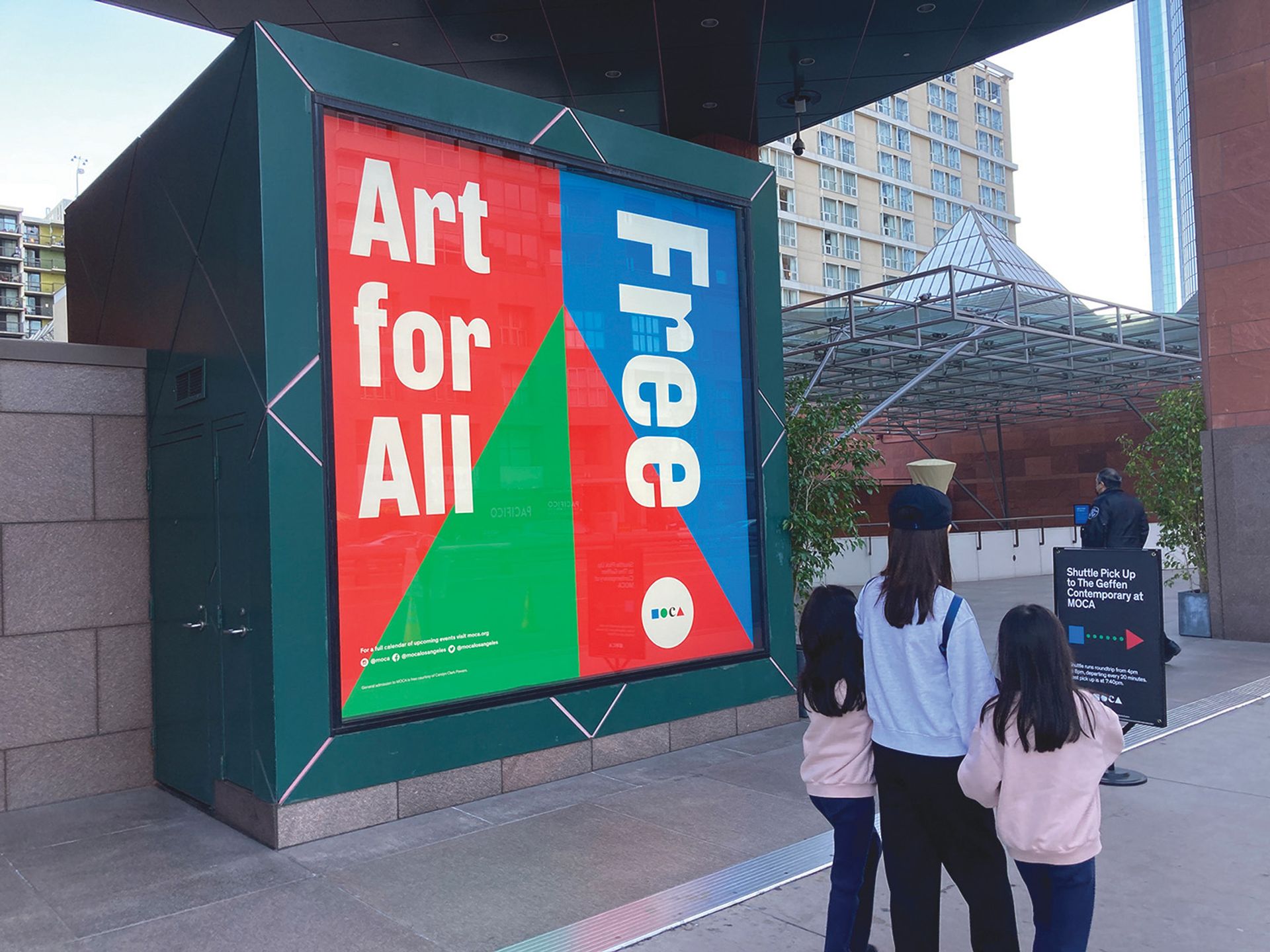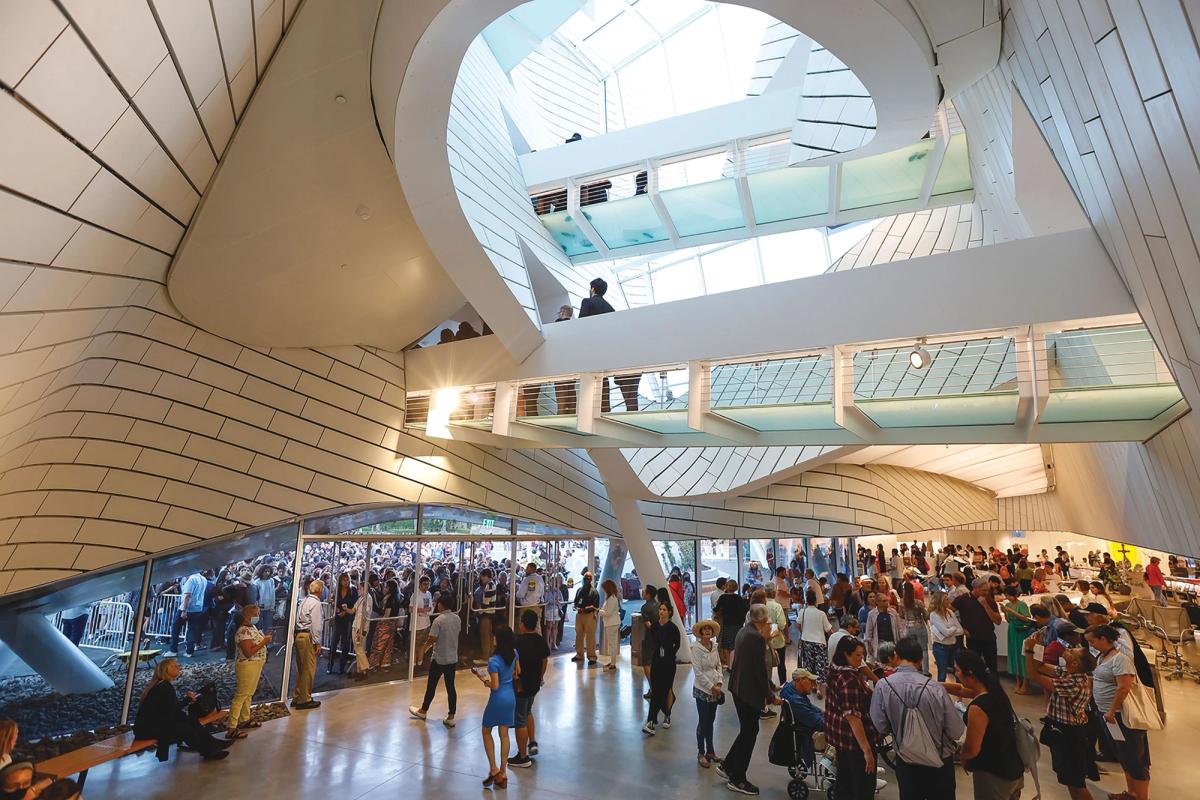When the Orange County Museum of Art (OCMA) opened in its new building last October, its leaders reached out to the public in ways they had never done before. They announced free admission for ten years, they had a 24-hour free-for-all opening event and they backed all of this up with large signage on the front door, reading: “Everyone is welcome.” And, so far, the gambit has helped pull in the biggest audience in the museum’s history.
OCMA has had more visitors in its first three months (92,000) than it used to see over a period of four years, says its director, Heidi Zuckerman. Never mind some withering reviews of Thom Mayne’s new building, where the strangest feature just might be a grand outdoor staircase cut in half to funnel people inside. “The numbers have been huge—the numbers of a much bigger institution,” Zuckerman says. “In my wildest dreams I didn’t imagine this many people would come and come repeatedly.”
OCMA is just the latest in a string of art museums in the Los Angeles area to go free. The Getty Center has been nominally free since its opening in 1997, though parking fees—and it is difficult to reach the museum without a car—have climbed to $20. In 2014, the easier-to-access Hammer Museum in Westwood went free under the director Ann Philbin with a tagline: “Free for LA. Free for you. Free for good.” The Broad downtown followed suit when it opened in 2015 for permanent collection exhibitions, although it still charges for Murakami-style blockbusters. Across the street, the Museum of Contemporary Art (Moca) went free at the start of 2020 for general admission and most temporary shows. (A recent Pipilotti Rist survey was an exception.) “I think many of us are at a point where we understand that museums should not be ivory towers,” said the then director Klaus Biesenbach. “Moca should feel like a public library where you can go and have access to culture.”
Pulling in new visitors
It makes for an interesting test case. Apart from Washington, DC, where so many museums are federally funded, the Los Angeles area has become home to the biggest free museum experiment in the US. And now, after a particularly busy open-doors decade, we are beginning to see some quantifiable results.

In early 2020 the Museum of Contemporary Art introduced free entry for general admission and most shows, made possible thanks to a $10m gift in 2019 from Carolyn Clark Powers, its board president Jori Finkel
Of course, the pandemic, which in Los Angeles County shut down museums for a long year, has scrambled recent attendance numbers for many institutions, which are just now beginning to match earlier figures. But there are other signs that the experiment is working, with directors reporting that they have been reaching unusually broad audiences in terms of age, racial diversity and, presumably, economic diversity.
“Pre-Covid we were attracting on average an audience that was 62% people of colour with an average age of 34, and those demographics appear to be holding,” says Joanne Heyler, the founding director at the Broad, which peaked at 920,000 visitors in 2019. “It’s easier to take a chance on something you don’t know if it involves not paying for a ticket.”
Philbin, who relays that around 50% of the Hammer’s visitors are people of colour and 65% are under 45, says that they have been seeing more repeat visitors as a result of going free, which also boosted attendance by around 15%. “We see many folks multiple times a week,” she says. “They come to meditation on Thursdays, they come for lunch, or they come to see a show. The fact that the Hammer is free allows it to become a regular gathering space for people.”
Moca director Johanna Burton says her museum gathers zip codes but rarely asks people to self-identify, so its information is largely anecdotal. But, she says, “Our frontline staff is reporting back on incredibly diverse audiences in all ways—racially and age-wise, and also from different walks of life, with a lot of non-art people coming in. Henry Taylor’s been a great show for that.”
Cameron Shaw, the director of the state-funded California African American Museum, which has been free since its founding in 1977, says she is glad to see more museums open their doors this way. “I think about visiting sites with friends or family, and the difference between an institution that’s free and one where I’m required to pay $20 is the difference between an easy Saturday or one that I have to factor into my budget.”
Still, all the directors emphasised that free admission alone is not enough to make a museum feel approachable or accessible. “Yes, free admission gets people in the door,” says Zuckerman, who also took the Aspen Art Museum free in 2008 when she was the director there, to great effect: attendance at the museum tripled. “But then it’s up to us to make people feel welcome.”
Removing more barriers
“Contemporary art can be weird or scary and it’s up to us to do everything we can to disavow that,” Zuckerman adds, mentioning the hiring of Spanish-speaking frontline staff as one example. “We want to remove as many barriers to entry as possible, not just financial.”
As Heyler puts it, free admission alone will not go far unless you are also committed to “changing what the main interface between institution and visitors looks and feels like”. The Broad is known especially for empowering its visitor services staff to engage in a more casual and personal way. “We’re really trying to signal as much as possible a kind of care and generosity towards the audience,” she says. “The phrase I constantly hear from visitors is that it just feels different here, which I take to mean the Broad does feel accessible in every sense—less stuffy, less rigid.”
The costs of a free-admission policy include not just the direct loss of an income stream from ticketing but also a potential erosion of dues from annual membership, which often has free entry as one of its perks. This double whammy helps to explain why popular museums in cities like New York, Chicago and San Francisco have not gone down this route. (In Los Angeles, the Los Angeles County Museum of Art has been one holdout, though it regularly has free days and hours.)
In order to compensate for its box-office loss, OCMA has raised $2.5m from Lugano Diamonds. The Hammer initially underwrote its free admission with $1m gifts from Erika J. Glazer and Brenda R. Potter, while Moca secured a $10m gift from its board president Carolyn Clark Powers in 2019, which Burton says will cover “at least a couple more years”. She and Philbin are already actively fundraising to subsidise free admission in the future.
“Our ideal scenario would be to create an endowment specifically for free admission because going back every few years to raise money for this is really difficult,” Philbin says. “But either way we are committed to this; there is no going backwards on free.”
These directors’ commitment also puts pressure on other local museums to go free. Under director Sandra Jackson-Dumont, the Lucas Museum of Narrative Art is already working hard to reach beyond the usual museum-goers, whether by building an exciting, multicultural collection or creating a new entrance to the museum’s Exposition Park campus on Vermont Avenue, where fences once kept South Los Angeles residents out. Even so, word on the street is that the billionaire filmmaker George Lucas is planning on charging admission when the museum opens in 2025.
With all the momentum in the other direction, it is bound to be a loaded decision, and the museum is not yet commenting. “The Lucas Museum will announce admissions and ticketing details closer to the opening,” a spokesperson says.


